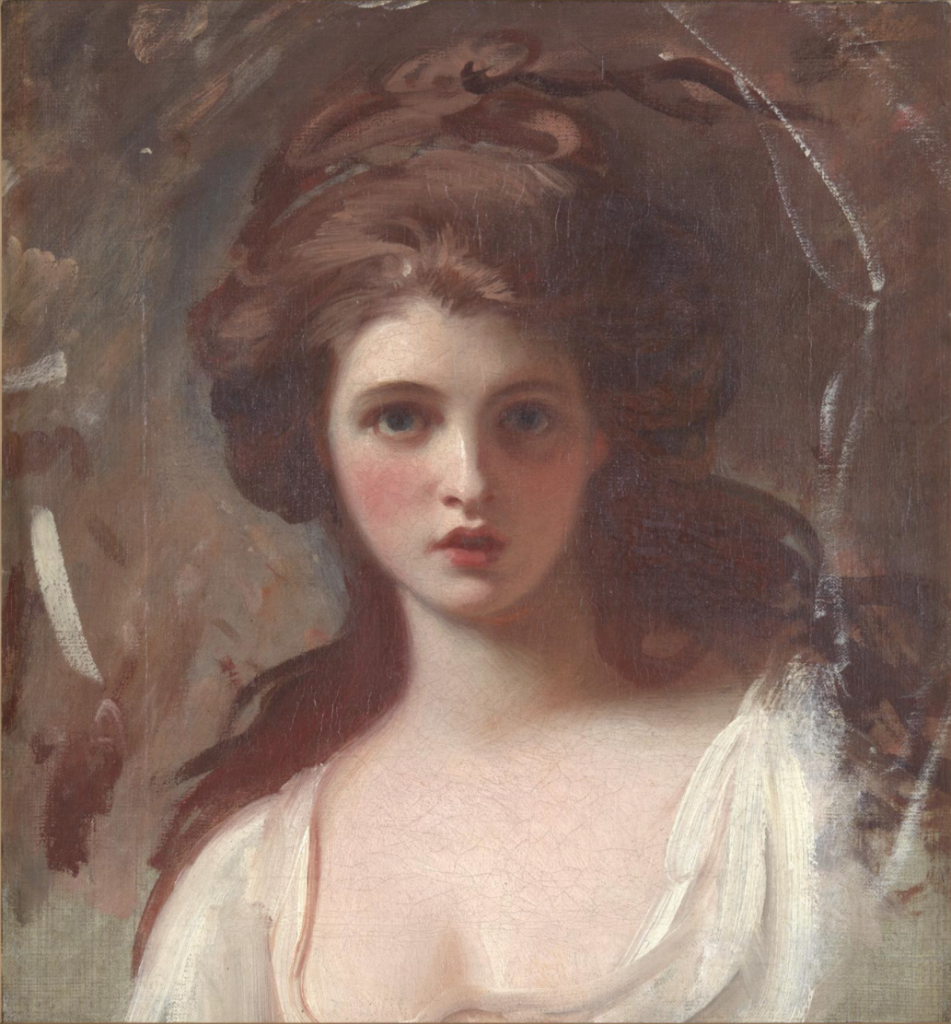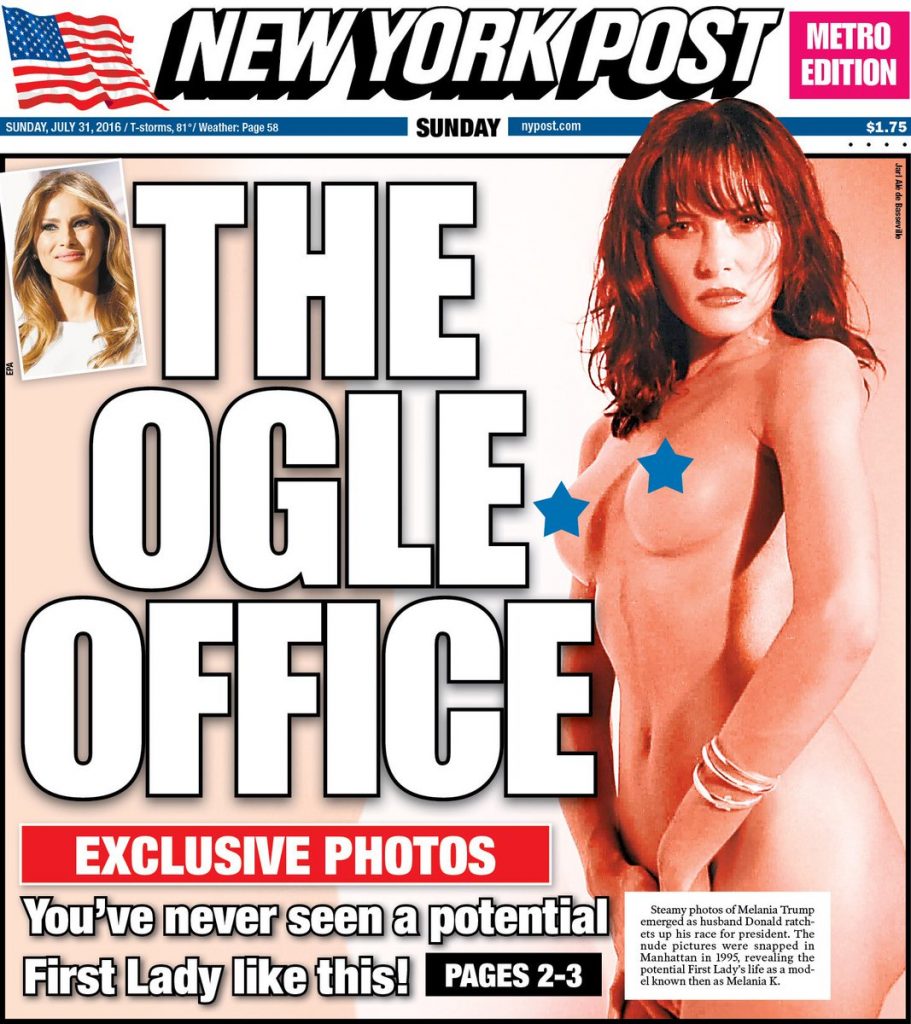Melania Trump normalized her first lady status last month by moving to the White House, but this shouldn’t prevent us from appreciating her disruptive qualities, apparent in February when Teen Vogue defended her against “slut shaming.” We’ve arrived at a new place when a first lady of the United States represents the occupational right to nude self-expression.
In its January 2000 issue, the British edition of GQ featured a “naked supermodel” special with a naked Slovenian model, then named Melania Knauss, gazing up from a dappled rug wearing platinum-hued bracelets, a glittering choker, and catlike eyeliner, her glowing front and girlish rear inviting tactile thoughts.
The photo resurfaced in 2016 when anti-Trump Republicans featured it in an ad headlined “Meet Melania Trump, your next first lady.” A few months later, The New York Post displayed a steamy photo of Melania from a mid-90s photo shoot on its front page. The expression in her eyes is both vulnerable and defiant. These images have spoken much louder than the few words she has spoken in her new public role.
The first foreign-born supermodel to occupy the White House has much in common with Europe’s first supermodel, Emma Hamilton. To understand the iconography of Melania Trump, we should acquaint ourselves with this British folk hero who died in 1815 just shy of her 50th birthday.
A recent show at the National Maritime Museum in the UK — entitled “Emma Hamilton: Seduction and Celebrity” — explored the origins of Emy Lyons, the daughter of a blacksmith from England’s northern countryside who made her way to London and occupied the city’s floating world of entertainment workers and pleasure seekers during her teens. She emerged from those adventures as Emma Hart.
Emma’s fame is due, in part, to a seven-year relationship with admiral Horatio Nelson, who died after winning the Battle of Trafalgar in 1805. But Emma was already a celebrity when she met Nelson.
Ten years before she became Lady Hamilton, Emma Hart was discovered by the British painter George Romney, who depicted her as Circe, St. Cecilia, and Shakespeare’s Miranda. On rare occasions, she appeared as herself. Together they produced more than 60 paintings, attracting other painters such as Joshua Reynolds, Elisabeth Louise Vigée Le Brun (famous for her portrait of Marie-Antoinette), and Angelica Kauffman. Romney missed her terribly when she left London for Naples.

More than a new face for painters of the 1780s, she was a new kind of persona, never a passive model, something of a gossip-magnet. Indeed, she was the supermodel prototype — harbinger of Kate Moss, Amber Valleta, and Melania Knauss.
In Italy, Emma shared a household with two men: her husband Sir William Hamilton and her lover Admiral Nelson. After Hamilton’s death, Emma lived with Nelson as his unofficial wife. Biographers have honored her with titles like England’s Mistress (2006) and Patriotic Lady (1936) by Marjorie Bowen, the genre novelist whose publishing debut turned young Graham Greene into an aspiring writer.
Both Melania and Emma have changed our idea of what’s possible for a woman in public life.
Melania’s father, an upwardly mobile car salesman in Sevnica (now located in Slovenia) was a Communist party member who owned a Maserati and a Mercedes. Viktor Knavs has been called “a larger-than-life personality” who influenced Melania’s taste in men. He was often on the road. Could this explain her decision to live, for the first months of her husband’s presidency, in New York instead of D.C.?
Melania’s appearance in Saudi Arabia and Rome this spring provoked snide chatter and misplaced admiration. Kathleen Parker described Melania — unveiled in the Middle East, clad in a white pantsuit — as a “beacon of light” for Saudi women. Later at the Vatican, her black lace Dolce and Gabbana ensemble (with mantilla veil) was said to have resembled widow’s weeds.
But Melania’s home is New York, where black does not symbolize mourning or obedience. To understand the first lady’s fashion moves, look not to pink-hatted ideologues or jobbing partisans. Instead we have the genius Diana Vreeland whose eye traveled as widely as the body of any world statesman, who — according to Richard Avedon — “invented the fashion editor.” Vreeland’s proclamation — that pink is the navy blue of India — predicted the truism that black is the pink of Manhattan.
Foes of Trump have been arguing that Melania is a victim of male egotism, but I see something else in their marriage: her successful narcissism married to his striving ego. When facing the camera, she’s doing someone a favor. She has done this before and doesn’t need our attention the way her husband does. Melania’s the winner in that marriage, mainly because of her regal way of conducting herself and her plain indifference to the spotlight — so unlike her husband. This may drive some feminists to spin feverish theories of abuse, but they underestimate the feminine ego.

The fuss over Melania’s nudity, the age difference in her marriage, brings to mind another first lady four decades ago.
Margaret Sinclair was 23, almost 30 years younger than Pierre Trudeau, when she married the prime minister of Canada in 1971. In 1979, this girlish mother of three was photographed at Studio 54, sitting casually on the floor signing autographs with her knees bent. Her skirt was long by current standards, but the fabric slipped low, revealing the first lady’s pubic hair — and the photo, circulating in the media, caused a sensation. She was caught in the act of simply being herself — it’s a beautiful and moving image, intimate and unpolished. She was already a wife (and mother of the future prime minister, Justin Trudeau) when Richard Manning photographed her — a first lady on a spree, breaking out of her official role.
Melania Knauss, however, made a conscious decision to pose nude. Snuggled up to a briefcase on her boyfriend’s private jet for GQ, Melania evokes Emma Hamilton embodying Nature for Romney or Thalia, the comic muse, for Angelica Kauffman.
The difference between Melania’s erotic presentation and Margaret Trudeau’s glimpsed womanhood is the difference between work and play, between collaboration and capture.

